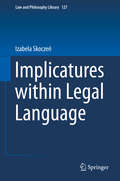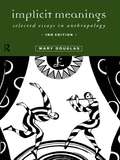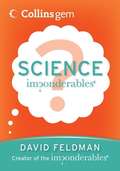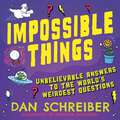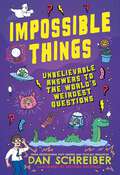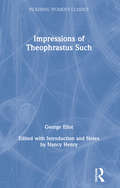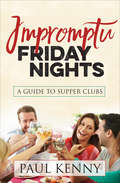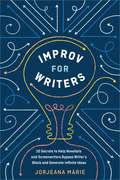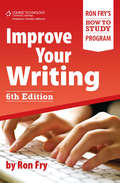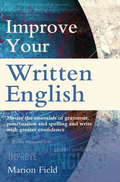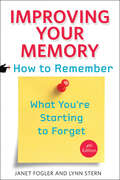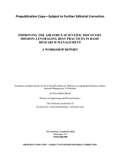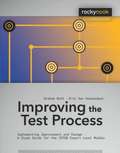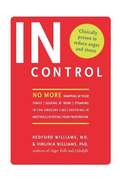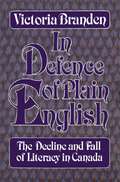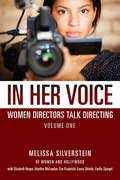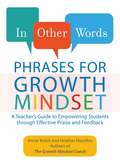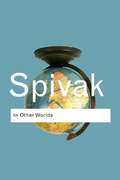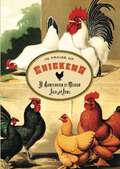- Table View
- List View
Implicatures within Legal Language (Law and Philosophy Library #127)
by Izabela SkoczeńThis book proposes a novel, descriptive theory that unveils the linguistic mechanisms lurking behind judicial decisions. It offers a comprehensive account of the ongoing debate, as well as a novel solution to the problem of understanding legal pragmatics.Linguistic pragmatics is based on a theory created by Paul Grice, who observed that people usually convey more than just the amalgam of the meaning of the words they use. He labeled this surplus of meaning a “conversational implicature.” This book addresses the question of whether implicatures occur in the legal language, firstly illustrating why the classic Gricean theory is not applicable (without substantial modification) to the description of legal language and proposing a novel approach based on a modification of Andrei Marmor’s “strategic speech.” Subsequently, it analyzes neo-Gricean theories and their limited use for describing the mechanisms of legal interpretation, and discusses the possibility of pragmatic enrichment of legal content as well as the notion of completeness of a legal proposition. Lastly, it illustrates how the developed theory works in practice, with examples from penal and civil law cases. The book is helpful to legal practitioners, since it provides insights into the reasons for and linguistic mechanisms behind courts’ decisions, but also to philosophers of law, philosophers of language, linguists and non-experts wishing to better understand the mechanisms of legal decision making.
Implicit Meanings: Selected Essays in Anthropology
by Professor Mary Douglas Mary DouglasImplicit Meanings was first published to great acclaim in 1975. It includes writings on the key themes which are associated with Mary Douglas' work and which have had a major influence on anthropological thought, such as food, pollution, risk, animals and myth. The papers in this text demonstrate the importance of seeking to understand beliefs and practices that are implicit and a priori within what might seem to be alien cultures.
Imponderables(R): Fun and Games
by David FeldmanIn gathering the most fascinating questions asked about sports and entertainment into a handy Gem format, pop culture guru David Feldman demystifies these and much more in Imponderables®: Fun and Games. Providing you with information you can't find in encyclopedias, dictionaries, or almanacs, Fun and Games is a fun look at the little things that make life so interesting.
Imponderables(R): Science
by David FeldmanIn gathering the most fascinating questions asked about science into a handy Gem format, pop culture guru David Feldman demystifies these and much more in Imponderables®: Science. Providing you with information you can't find in encyclopedias, dictionaries, or almanacs, Science is a fun look at the little things that make life so interesting.
Impossible Things: The book to answer your child’s most weird and wonderful questions!
by Dan SchreiberThe perfect book for young curious minds who love to ask WEIRD and WONDERFUL questions.Did dinosaurs beat us to the moon?Is the Loch Ness Monster real?Can imaginary friends come to life?Should we all be learning to speak cat?Want to impress your friends and family with some BANANAS but TRUE facts? Then discover the world of impossible things with fact detective Dan Schreiber. This book will give you the answers to all of your big questions, no matter how silly! From discovering if monsters are real to seeking out haunted sausage rolls, exploring the world's strangest curses to finding the truth about time travel, this book has everything!With hilarious illustrations and comic strips in every chapter, you won't want to put this book down!
Impossible Things: The book to answer your child’s most weird and wonderful questions!
by Dan SchreiberThe perfect book for young curious minds who love to ask WEIRD and WONDERFUL questions.Did dinosaurs beat us to the moon? Is the Loch Ness Monster real?Can imaginary friends come to life?Should we all be learning to speak cat?Want to impress your friends and family with some BANANAS but TRUE facts? Then discover the world of impossible things with fact detective Dan Schreiber. This book will give you the answers to all of your big questions, no matter how silly! From discovering if monsters are real to seeking out haunted sausage rolls, exploring the world's strangest curses to finding the truth about time travel, this book has everything!With hilarious illustrations and comic strips in every chapter, you won't want to put this book down!
Impressions of Theophrastus Such: Essays And Leaves From A Note-book (classic Reprint) (Pickering Women's Classics)
by George EliotGeorge Eliot (1819-80) is one of the most widely-read of the 19th-century novelists and story-writers. "Impressions of Theophrastus Such" appeared in 1879, Eliot's last completed work. It consists of 18 short essays narrated by a middle-aged bachelor, Theophrastus.
Impromptu Friday Nights: A Guide to Supper Clubs
by Paul KennyThe ultimate guide to hosting dinner parties of every size, from choosing guests to choosing themes—includes recipes and menu plans. Almost everyone likes to socialize over a meal. Supper clubs that bring people together to enjoy a meal are natural enablers. The concept of supper clubs (hosting regular dinner parties) seems simple, but the &“how to&” can be daunting. Impromptu Friday Nights shows the reader how to set up supper clubs, provides options for different club formats, from large and formal to small and informal, and includes sample menus with recipes. Author Paul J. Kenny and his wife have been in many different types of supper clubs for most of their adult lives. They have been in large, formal clubs, small, informal ones and several others in between. Through these experiences, Paul has learned what works for a group and what doesn&’t. As part of these clubs, he has been writing menus and recipes for years. He is a foodie and comes from a long line of foodies who love to entertain. &“Paul Kenny&’s Impromptu Friday Nights directs the reader to focus on the most important building blocks of successful culinary entertainment . . . In an era of over-promising, misleading complexity, and verbosity this book simplifies the task, empowers the host to shine, and grants him/her success every time.&” —Lucien Vendôme, former director of culinary innovation for Nestle
Improv for Writers: 10 Secrets to Help Novelists and Screenwriters Bypass Writer's Block and Generate Infinite Ideas
by Jorjeana MarieFree yourself from writer’s block and inner critics with the creative power of improv! “Jorjeana Marie’s generous, joyful, and oh-so-useful book shows writers—both seasoned and new—how to unleash their creativity and find their best story.”—Gayle Forman, New York Times bestselling author of If I Stay and I Have Lost My Way Improv instructor and writer Jorjeana Marie reveals a new way to generate idea after brilliant idea. Applying the rules of improv to fiction writing, Marie presents fun games and exercises you can do from the comfort of your desk at home. Surprise yourself with new plots, infinite characters and settings, and a supreme confidence in your own process. Armed with the power of improv—and liberating exercises like Ad Agency, Raise the Stakes, and Family Portraits—you’ll soon be an idea machine. With Improv for Writers, your creative storytelling well will never run dry again.Advance praise for Improv for Writers“Here’s a secret. Many authors started out as drama geeks and later found that theatrical skills like deep-diving into character and improvising on the fly were essential tools for writing fiction. Jorjeana Marie’s generous, joyful and oh-so useful book applies the principles of improv to writing and though a series of targeted, fun exercises shows writers—both the seasoned and the new—how to unleash their creativity and find their best story.”—Gayle Forman, New York Times bestselling author of If I Stay and I Have Lost My Way “Part practical, part playful, part encouraging and affirming, Jorjeana Marie’s Improv for Writers is a certain antidote to writing blocks—and writer’s block! This book is a necessary and vital tool for authors and storytellers everywhere.”—Karma Brown, bestselling author of The Life Lucy Knew“Thank you, Jorjeana Marie for infusing joy and play and experimentation in the often-arduous act of writing fiction. I'll be turning to these exercises whenever I need to jump-start my writing session and will be recommending many of my writing students to do the same.”—Nina LaCour, Michael L. Printz Award-winning author of We Are Okay, Hold Still, The Disenchantments, and Everything Leads to You; and You Know Me Well, a novel written in collaboration with David Levithan.
Improve Your Writing
by Ron FryFrom selecting a topic and conducting research to developing an outline, writing drafts, proofreading, and more, Improve Your Writing takes you step-by-step through the creation of a successful research paper. Applicable to any kind of writing addressing any subject matter, author Ron Fry's fundamental and systematic approach goes beyond one size fits all checklists to offer real advice that can be adapted according to your individual needs and situations. Ideal for anyone hoping to establish essential research, organization, and writing skills, the text empowers you to excel in school, on essay tests, and in life.
Improve Your Written English: Master The Essentials Of Grammar, Punctuation And Spelling And Write With Greater Confidence (How To Bks)
by Marion FieldWritten in short, accessible sections, this book explains the basics of writing good English. It includes punctuation, sentence construction and spelling. You will learn how to adopt different tasks, such as writing a report, essay or short story. There are also chapters on letter writing, filling in forms and constructing job applications.
Improve Your Written English: Master the essentials of grammar, punctuation and spelling and write with greater confidence
by Marion FieldWritten in short, accessible sections, this book explains the basics of writing good English. It includes punctuation, sentence construction and spelling. You will learn how to adopt different tasks, such as writing a report, essay or short story. There are also chapters on letter writing, filling in forms and constructing job applications.
Improving Your Memory: How to Remember What You're Starting to Forget
by Janet Fogler Lynn Stern“The finest handbook we’ve seen on the subject.” —AARP MagazineAppliances and car lights turn themselves off. Smartphones and laptops remind us of appointments. Google lets us search for information we can’t remember. Yet with all these advances, we still grow frustrated and anxious when words won’t come, when we misplace items, or when we forget the name of the person in front of us.Now, University of Michigan social workers Janet Fogler and Lynn Stern have completely updated their friendly, practical guide to memory improvement techniques, many of which can provide immediate results. Recognizing that people worry something is wrong with them when they forget things, they suggest that the antidote to worry is taking positive action to help us remember what we want to remember. They provide tools for understanding and improving memory, including sixteen helpful exercises. Simple techniques like writing information down, creating a catch word or phrase, altering something in your environment, and reviewing details in advance can put you actively in charge of retrieving information more easily.As in previous editions, Improving Your Memory reinforces memory techniques through real-life examples. This accessible handbook also discusses how memory works; how it changes with age, stress, illness, and depression, and why people remember what they do.“One of the most complete memory training guides available . . . This volume has clearly emerged from considerable practical experience with conducting memory courses.” —Contemporary Gerontology
Improving the Air Force Scientific Discovery Mission: A Workshop Report
by Committee on Improving the Air Force Scientific Discovery Mission: Leveraging Best Practices in Basic Research Management: A WorkshopIn 2014, the Air Force Studies Board conducted two workshops to review current research practices employed by the Air Force Office of Scientific Research (AFOSR). "Improving the Air Force Scientific Discovery Mission" summarizes the presentation and discussion of these two workshops. This report explores the unique drivers associated with management of a 6. 1 basic research portfolio in the Department of Defense and investigates current and future practices that may further the effective and efficient management of basic research on behalf of the Air Force.
Improving the Test Process
by Graham Bath Erik Van VeenendaalThis book covers the syllabus for the Improving the Test Process module of the International Software Testing Qualifications Board (ISTQB) Expert Level exam. To obtain certification as a professional tester at the Expert Level, candidates may choose to take a course given by an ISTQB accredited training provider and then sit for the exam. Experience shows that many candidates who choose this path still require a reference book that covers the course. There are also many IT professionals who choose self-study as the most appropriate route toward certification. This book can be used both as a preparation guide for those planning to take the ISTQB Expert Level certification exam and as a practical guide for experienced testing professionals who want to develop their skills in improving test processes.
In A Pickle: Other Funny Idioms
by Marvin TerbanThirty common English phrases, such as "a chip off the old block" and "cry over spilled milk" are explained.
In Case You Get Hit by a Bus: How to Organize Your Life Now for When You're Not Around Later
by Gene Newman Abby Schneiderman Adam SeiferA step-by-step program for getting your life in order, so you&’re prepared for the unexpected. The odds of getting hit by a bus are 495,000 to 1. But the odds that you&’re going to die some day? Exactly. Even the most disorganized among us can take control of our on- and off-line details so our loved ones won&’t have to scramble later. The experts at Everplans, a leading company in digital life planning, make it possible in this essential and easy-to-follow book. Breaking the task down into three levels, from the most urgent (like granting access to passwords), to the technical (creating a manual for the systems in your home), to the nostalgic (assembling a living memory), this clear, step-by-step program not only removes the anxiety and stress from getting your life in order, it&’s actually liberating. And deeply satisfying, knowing that you&’re leaving the best parting gift imaginable. When you finish this book, you will have:A system for managing all your passwords and secret codesOrganized your money and assets, bills and debtsA complete understanding of all the medical directives and legal documents you need––including Wills, Powers of Attorney, and TrustsA plan for meaningful photos, recipes, and family heirloomsRecords of your personal history, interests, beliefs, and life lessonsAn instruction manual for your home and vehiclesYour funeral planned and obituary written (if you&’re up for it)
In Control: No More Snapping at Your Family, Sulking at Work, Steaming in the Grocery Line, Seething in Meetings, Stuffing Your Frustration
by Redford Williams Virginia WilliamsClinically proven to reduce anger and stress, this book's easy-to-follow program will enable you to handle anything that today's dangerously out-of-control world throws at you.
In Defence of Plain English: The Decline and Fall of Literacy in Canada
by Victoria BrandenThis indispensable guide to the English language belongs beside the dictionary in every Canadian home. Written in an easy-to-understand light-hearted style, the content of the book is nevertheless serious and important. Our language is declining; illiteracy is rampant. Worse, the sloppy, incorrect use of language is perpetrated by educators, the media, politicians, and others who should be setting a good example.Besides giving simple illustrations of the correct use of grammar and choice of words, the author deals with the commonest offences: language misused, mis-spelled, and misunderstood, and the appalling use of words (usually incorrect) that many people consider sophisticated or "classy."Using actual quotations from essays of university students, the media, and even "good" books, the author clearly defines bad English and explains in a straightforward manner how to change it to good English. What makes this book unique is its complete lack of pretentiousness and its powerful plea for the return of plain English.
In Her Voice: Women Directors Talk Directing
by Melissa SilversteinIn Her Voice is the first book that takes the words and experiences of a diverse group of celebrated women film directors and puts their voices front and center. This unique volume of interviews presents more than 40 feature and documentary directors from around the world, including Debra Granik (Winter's Bone), Courtney Hunt (Frozen River), Callie Khouri (Mad Money), Sally Potter (Rage), Lone Scherfig (An Education) and Lynn Shelton (Humpday). In Her Voice is a call to arms and a reminder to movie lovers, students and the entertainment industry about the significance of women directors and their growing, integral position in the world of filmmaking. It is also a message for women directors to not give up?--your voice counts. Your vision matters.
In Love in New York
by Jacob Lehman Caitlin LeffelNew York is a city for lovers: In Love in New York guides the reader to the most romantic sights and destinations the city has to offer. Whether you want to watch the sun rise over the East River like Woody and Diane or enjoy a Cary Grant/Deborah Kerr moment at the top of the Empire State Building, there is no greater city than New York for couples in love. The book begins with "first impressions," the iconic New York sights that never fail to dazzle: the skyline (and the best places to view it), the most beautiful blocks and neighborhoods, the famous views (rooftops, bridges, riverside parks). Chapters follow on great date ideas, including destination museums and unusual "dinner-and-a-movie/theater" combinations. For readers ready to commit, the authors detail the best proposal spots; where to go ring shopping; the coolest places to register for gifts; and information about the legal requirements for marrying in the city (gay and straight), including a rundown on the classic City Hall wedding--with the best places to buy flowers and to celebrate afterwards, naturally. There are also ideas for planning honeymoons and anniversaries. Throughout, sidebars offer romantic options such as wonderful bars with fireplaces, the prettiest park benches, great New York literary and film affairs to inspire your visit, and romantic day trips within and near the five boroughs. From champagne on the Peninsula rooftop in midtown to ice skating in Bryant Park, In Love in New York is the perfect gift for any couple dreaming of experiencing the romance of New York.
In Memoriam
by Amanda Bennett Terence B. FoleyThis practical, innovative guide takes friends and family through every step of planning a funeral or memorial service. It also offers detailed advice on how to make any service truly personal--from writing tributes and choosing appropriate music to selecting speakers, organizing the time and place, arranging flowers, and much more.
In Other Words: A Teacher's Guide to Empowering Students through Effective Praise and Feedback (Growth Mindset for Teachers)
by Annie Brock Heather HundleyLearn how to effectively bring growth mindset into your community and classroom by choosing impactful language.From the authors of the bestselling The Growth Mindset Coach, this handy companion is a must-have if you want to empower students through purposeful praise and feedback. Here are the key strategies, helpful tips and go-to phrases for helping students transition thoughts, words and actions into the growth-mindset zone.Designed for ease of use and packed with over a hundred specific examples, this book offers a “say this, not that” approach to communication that will help you model and cultivate growth mindset in the classroom. For example:Fixed Mindset:• You’re so smart.• You’re wrong.Growth Mindset:• l like how you used different strategies to figure out these problems.• That didn’t work out for you. How could you approach the problem differently?
In Other Worlds: Essays In Cultural Politics (Routledge Classics)
by Gayatri Chakravorty SpivakIn this classic work, Gayatri Chakravorty Spivak, one of the leading and most influential cultural theorists working today, analyzes the relationship between language, women and culture in both Western and non-Western contexts. Developing an original integration of powerful contemporary methodologies – deconstruction, Marxism and feminism – Spivak turns this new model on major debates in the study of literature and culture, thus ensuring that In Other Worlds has become a valuable tool for studying our own and other worlds of culture.
In Praise of Chickens: A Compendium of Wisdom Fair and Fowl
by Jane SmithWhat follows is a compact miscellany of chicken wisdom—a lively and amusing collection of quotations from past authorities on all things chicken, interspersed with brief editorial comments and complemented by wonderful illustrations. Whether a single sentence or several paragraphs, selections are all little known and long on charm. In Praise of Chickens can be savored in small pieces or enjoyably devoured all at once. It includes a demonstration of how to hypnotize a chicken; an account of a chicken rodeo; Mark Twain’s sly tips on raising chickens; and a dictionary of the twenty-three-word vocabulary of the domestic chicken.
